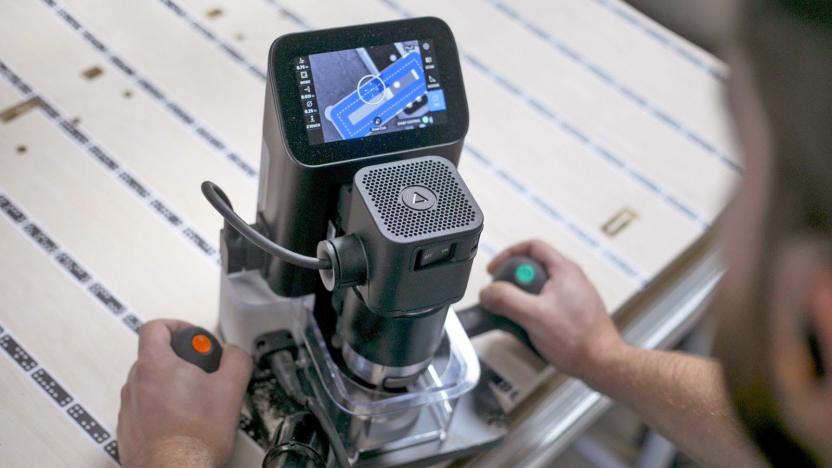CncRouter
Latest

Shaper's AR-equipped Origin power cutter is going on sale for $2,500
If you've been itching to add AR to your DIY with a handheld CNC, you'll be happy to know that Shaper's Origin augmented reality power cutter will once again be available for purchase. Originally launched in 2016, Origin scans visual markers and then displays a guide on the device's screen to direct where you cut. If you get too far off your design, the blade will retract.

Desktop construction gets a boost from the compact Nomad CNC machine
Desktop 3D printers have offered makers their building chops for some time now, and Carbide 3D is looking to do the same with a highly capable CNC machine. This is the Nomad 883: a mill that takes building beyond ABS and PLA plastics to wood, brass, aluminum and more. The unit wields a brushless DC spindle motor that routs designs on an 8 x 8-inch machining area. Sure, we've seen compact CNC options before, all with varying degrees of utility and durability. Here, a solid aluminum frame is enclosed on the sides with either bamboo or plastic and there's a polycarbonate lid to keep noise and dust to a minimum -- key downsides to most CNC equipment. In terms of exact size, the Nomad ticks the tape at 19 x 17 x 16in. (around 48 x 43 x 40cm) and weighs in at a somewhat hefty 50lbs/22.68kg (for comparison, a MakerBot Replicator 2X is 39.25lbs/17.8kg). If you're looking to snag one, you'll have to wait for the fourth production run (set to ship in November) and be willing to part with $1,999. That's a $500 discount for Kickstarter backers, and the price tag includes a smattering of building materials and two software options to get things started.

FABtotum 3D prints and scans, mills, takes one step closer to self-replication
Granted, the name's a bit of a groaner (and we now have pictures of Bukowski sitting in front of a CAD program in our heads), but this box is capable of a pretty impressive array of maker activities. There's a 3D Printer, 3D scanner and CNC router on board. You can capture objects and print them out on the same device and do some subtractive manufacturing by way of a dual-head engraving / milling tool that can cut into wood and do PCB milling for circuit boards. FABtotum is currently up on Indiegogo, if you want to get in early. A final consumer version will run you a $1,099 pledge. Those units are expected to be delivered in May of next year.

Handibot Smart Tool hits Kickstarter, cuts in 3D with mobile controls (video)
While CNC routers are part-digital by their nature, they haven't really kept up with the times: they're often fixed in place and don't easily adapt to unique tasks. ShopBot Tools hopes to modernize these machines by crowdfunding its Handibot Smart Tool. The device is portable and cuts 3D shapes out of many flat surfaces, but its specialty is the accessible, app-driven control that the fundraising will support. Builders can give the Handibot a wide range of instructions through apps on PCs or (eventually) mobile devices, whether they need a few simple holes or large, ornate patterns. Those pledging support will need to spend at least $1,995 to get a Handibot this September, assuming ShopBot reaches its $125,000 goal; still, it may be worth the cost for any workshop enthusiast who feels limited by existing tools.

WikiHouse promises printable homes, work for the world's idle CNC routers
If you want something done right, do it yourself. That includes building a house, but that's a project out of reach for many DIYers. Enter WikiHouse, a community for open-source home designs. There you can mix and match architectural plans using Google SketchUp; once you've settled on your dream home, just print to your waiting CNC router and start building. That's the idea, anyway: the site's still under construction, with the designers planning to debut the first WikiHouse in September during South Korea's Gwangju Design Biennale 2011. Sure, it certainly won't be as flashy as Electronic House's Home of the Year, where wall-mounted iPads control the shower temperature, or Sharp's prototype zero-emission house, with its 180-inch LCD. But does suggest a new, DIY way of thinking about the "home of the future."




